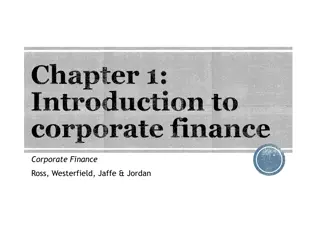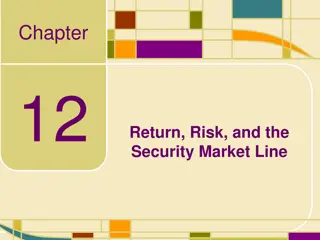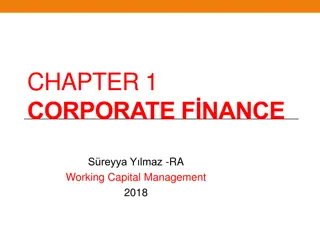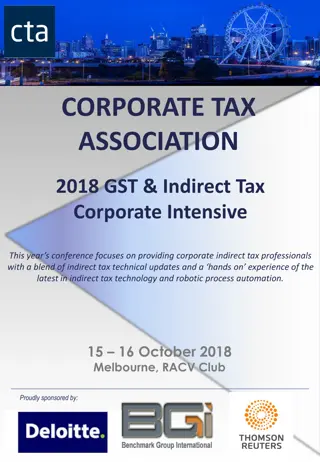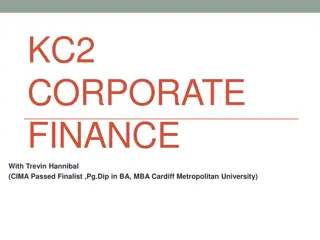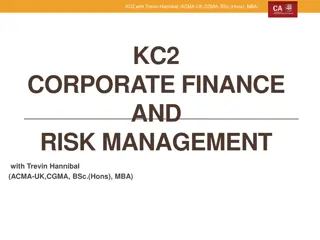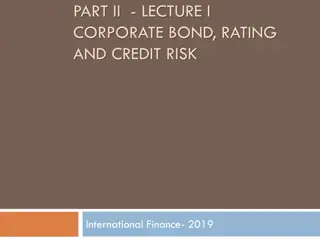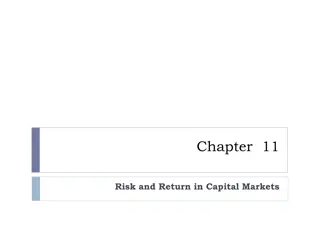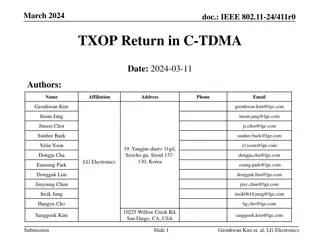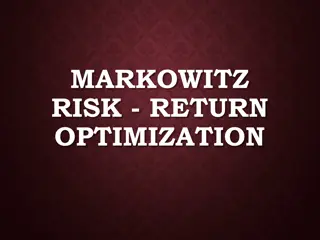Understanding Risk and Return in Corporate Finance
Exploring risk and return in market history is crucial for determining appropriate returns on assets. By analyzing dollar returns, percentage returns, holding period returns, and capital market returns, investors can grasp the risk-return tradeoff. Lessons from capital market return history emphasize the positive relationship between risk and return, highlighting the reward for bearing risks.
Download Presentation

Please find below an Image/Link to download the presentation.
The content on the website is provided AS IS for your information and personal use only. It may not be sold, licensed, or shared on other websites without obtaining consent from the author. Download presentation by click this link. If you encounter any issues during the download, it is possible that the publisher has removed the file from their server.
E N D
Presentation Transcript
Chapter 10: Risk and return: lessons from market history Corporate Finance
Outline I. Returns II. Capital market returns III. Portfolio risk statistics
Dollar return Suppose that you bought a bond for $1050 a year ago. You have received two semiannual coupons of $50 each. The market price of the bond today is $1100. What is your total dollar return? Income = 50 + 50 = $100. Capital gain = 1100 1050 = $50. Total dollar return = 100 + 50 = $150. Total dollar return = income + capital gain (loss).
Percentage return It is more intuitive to think of returns in terms of percentages. Return = (ending value beginning value) / beginning value. Return = ((1100 + 100) 1050) / 1050 = 14.29%. Return = income yield (return) + capital gain yield (return) = 100 / 1050 + 50 / 1050 = 9.52% + 4.76% = 14.29%.
A sample question Six months ago, you purchased 100 shares of stock in ABC Co. at a price of $43.89 a share. ABC stock pays a quarterly dividend of $.10 a share. Today, you sold all of your shares for $45.13 per share. What is the total dollar amount of your capital gains on this investment of 100 shares? a. $1.24 b. $1.64 c. $40.00 d. $124.00 e. $164.00
Holding period return Holding period return: the cumulative return that an investor would obtain when holding an investment over a period of N years.
Holding period return example Suppose that an investment yielded 4%, 7%, 8%, 0%, and 10% for the past 5 years. What is the holding period return for the 5 years? Holding period return = (1 + 4%) (1 + 7%) (1 + 8%) (1 + 0%) (1 + 10%) 1 = 32.2%.
Why capital market returns? Examining capital market returns helps us determine the appropriate returns on non-financial assets (e.g., firm projects). Lessons from capital market return history: There is a reward for bearing risk. Return is positively related to risk. This is called the risk-return tradeoff.
Average return, I The simple average of a series of returns is called arithmetic average return. Geometric average return: average compound return per period over multiple periods.
Average return example Year 1 2 3 4 5 Ret 0.08 -0.01 0.12 0.13 0.06 Multiplication term Arithmetic R 1 + Ret Power of 1/N Geometric R 0.076 1.08 1.074811381 0.07481138 0.99 1.12 1.13 1.06 1.4344 GR < AR
Average return, II The geometric average will be less than the arithmetic average unless all the returns are equal. The arithmetic average is overly optimistic for multiple horizons. If the investment horizon is only 1 period, the arithmetic average is a better measure of likely return. Arithmetic average return based on historical returns are often used as an estimate of expected return in real life.
A sample question The average compound return earned per year over a multi-year period is called the _____ average return. a. arithmetic b. standard c. variant d. geometric e. real
Portfolio risk statistics An investor cares about the return variability of her/his portfolio. This variability at the portfolio level is usually measured by variance and/or standard deviation (std.).
Portfolio risk statistics, based on a sample Year 1 2 3 4 5 Ret 0.08 -0.01 0.12 0.13 0.06 Arithmetic R 0.076 Diff 0.004 -0.086 0.044 0.054 -0.016 Sum Diff^2 0.000016 0.007396 0.001936 0.002916 0.000256 0.01252 Var Std 0.00313 0.055946
Historical performance, 1926-2011 Average Return Std (Geometric Mean) 11.8% (9.8%) 20.3% 16.5% (11.9%) 32.5% 6.4% (6.1%) 8.4% 6.1% (5.7%) 9.8% 3.6% (3.6%) 3.1% 3.1% (3.0%) 4.2% Large stocks Small Stocks L-T Corporate Bonds L-T Government Bonds U.S. Treasury Bills Inflation
Market risk premium Market risk premium is the difference between expected equity market return and the risk-free rate. Approximately 6.9%. Based on 1900-2010 data, across 17 countries.
If normally distributed? If we are willing to assume that asset returns are normally distributed, can you draw a return distribution based on the previous slide? Hint: about 95% within +/ 2 std.
End-of-Chapter Concept questions: 1-10. Questions and problems: 1-16 and 19-23.





